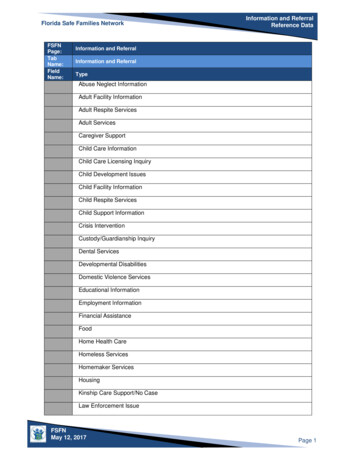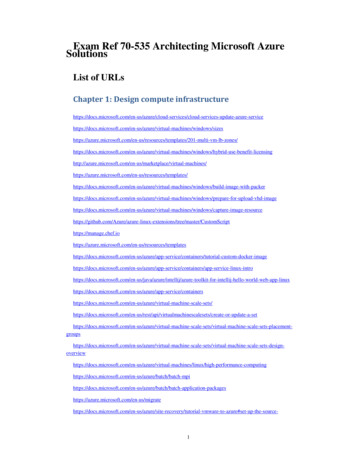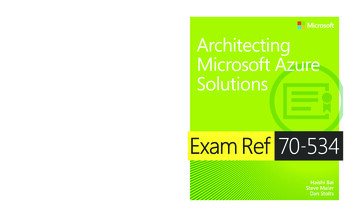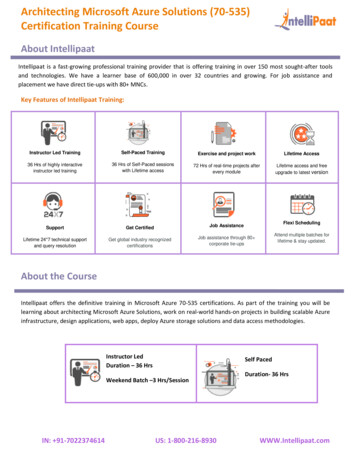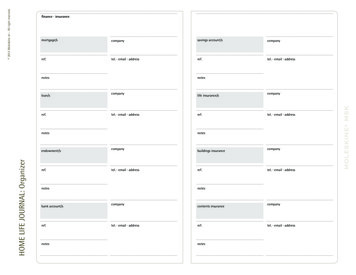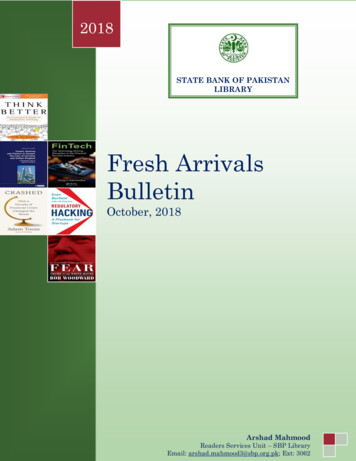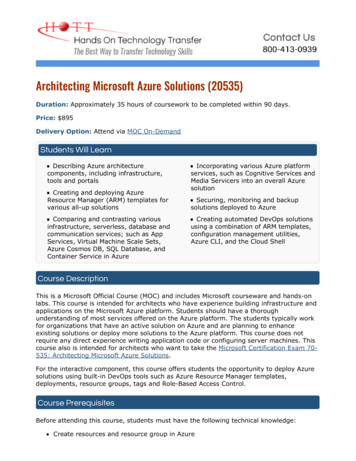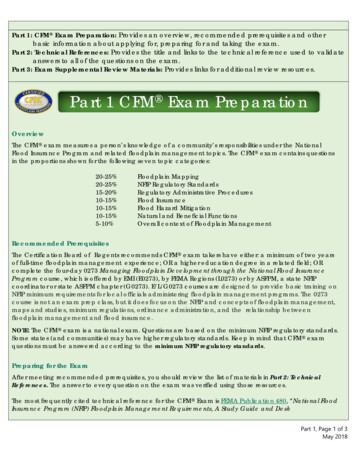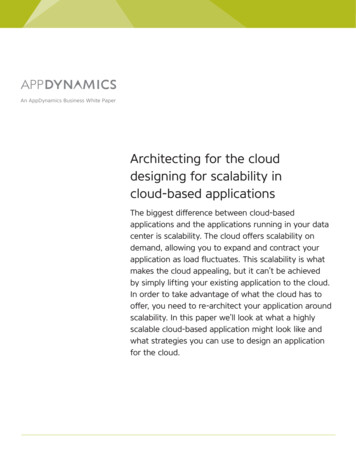
Transcription
Exam Ref 70-535Architecting MicrosoftAzure SolutionsHaishi BaiDan StoltsSantiago Fernández Muñoz
Exam Ref 70-535 Architecting Microsoft Azure SolutionsPublished with the authorization of Microsoft Corporation by:Pearson Education, Inc.Copyright 2018 by Pearson EducationAll rights reserved. This publication is protected by copyright, and permission must be obtained from the publisher prior toany prohibited reproduction, storage in a retrieval system, or transmission in any form or by any means, electronic, mechanical,photocopying, recording, or likewise. For information regarding permissions, request forms, and the appropriate contacts withinthe Pearson Education Global Rights & Permissions Department, please visit www.pearsoned.com/permissions/. No patentliability is assumed with respect to the use of the information contained herein. Although every precaution has been taken in thepreparation of this book, the publisher and author assume no responsibility for errors or omissions. Nor is any liability assumed fordamages resulting from the use of the information contained herein.ISBN-13: 978-1-5093-0468-4ISBN-10: 1-5093-0468-1Library of Congress Control Number: 20189390741 18TrademarksMicrosoft and the trademarks listed at https://www.microsoft.com on the “Trademarks” webpage are trademarks of theMicrosoft group of companies. All other marks are property of their respective owners.Warning and DisclaimerEvery effort has been made to make this book as complete and as accurate as possible, but no warranty or fitness is implied.The information provided is on an “as is” basis. The authors, the publisher, and Microsoft Corporation shall have neitherliability nor responsibility to any person or entity with respect to any loss or damages arising from the information containedin this book or programs accompanying it.Special SalesFor information about buying this title in bulk quantities, or for special sales opportunities (which may include electronicversions; custom cover designs; and content particular to your business, training goals, marketing focus, or brandinginterests), please contact our corporate sales department at corpsales@pearsoned.com or (800) 382-3419.For government sales inquiries, please contact governmentsales@pearsoned.com.For questions about sales outside the U.S., please contact intlcs@pearson.com.Editor-in-ChiefGreg WiegandSenior Acquisitions EditorLaura NormanDevelopment EditorTroy MottManaging EditorSandra SchroederSenior Project EditorTracey CroomEditorial ProductionBackstop MediaCopy EditorChristina RudloffIndexerJulie GradyProofreaderLiv BainbridgeTechnical EditorJason HaleyCover DesignerTwist Creative, Seattle
I would like to dedicate this book to editors, technical reviewersand co-authors. It’s been a long and collaborative process to getthe book out. I appreciate your dedication, professionalism andpersistence to complete the quest.—Haishi BaiI would like to dedicate this book to my son Brad. His love, encouragement, drive and motivation gave me the strength to get to thefinish line.—Dan StoltsI would like to dedicate this book to my wife Rocio, for supportingme all the time I spent on this and other projects and being themost important reason on my life to be a better person.—Santiago Fernández Muñoz
Contents at a glanceIntroductionxvImportant: How to use this book to study for the examxixCHAPTER 1Design compute infrastructure1CHAPTER 2Design data implementationCHAPTER 3Design networking implementation149CHAPTER 4Design security and identity solutions193CHAPTER 5Design solutions by using platform services249CHAPTER 6Design for operations279Index31985
ContentsIntroductionxvAcknowledgments. . . . . . . . . . . . . . . . . . . . . . . . . . . . . . . . . . . . . . . . . . . . . . . . . . . . . xiiOrganization of this book. . . . . . . . . . . . . . . . . . . . . . . . . . . . . . . . . . . . . . . . . . . . . . xvMicrosoft certifications . . . . . . . . . . . . . . . . . . . . . . . . . . . . . . . . . . . . . . . . . . . . . . . . xvMicrosoft Virtual Academy. . . . . . . . . . . . . . . . . . . . . . . . . . . . . . . . . . . . . . . . . . . . xviQuick access to online references. . . . . . . . . . . . . . . . . . . . . . . . . . . . . . . . . . . . . . xviErrata, updates, & book support. . . . . . . . . . . . . . . . . . . . . . . . . . . . . . . . . . . . . . . xviiStay in touch. . . . . . . . . . . . . . . . . . . . . . . . . . . . . . . . . . . . . . . . . . . . . . . . . . . . . . . . . xviiImportant: How to use this book to study for the examChapter 1Design compute infrastructurexix1Skill 1.1: Design solutions using virtual machines. . . . . . . . . . . . . . . . . . . . . . . . . . 2Design VM deployments by leveraging Availability sets,Fault Domains, and Update Domains in Azure3Design for compute-intensive tasks using Azure Batch21Define a migration strategy from cloud services23Skill 1.2: Design solutions for serverless computing . . . . . . . . . . . . . . . . . . . . . . 32Use Azure Functions to implement event-driven actions32Design for serverless computing using Azure Container Instances 36Design Application Solutions by using Azure Logic Apps,Azure Functions, or both38Determine when to use API Management service40Skill 1.3: Design microservices-based solutions . . . . . . . . . . . . . . . . . . . . . . . . . . 41Determine when a container-based solution is appropriate41Determine when container-orchestration is appropriate43Determine when Azure Service Fabric (ASF) is appropriate44Determine when Azure Functions is appropriate44Determine when to use the API Management service44Determine when Web API is appropriate45vii
Determine which platform is appropriate for containerorchestration45Consider migrating existing assets versus cloudnative deployment47Design lifecycle management strategies49Skill 1.4: Design web applications . . . . . . . . . . . . . . . . . . . . . . . . . . . . . . . . . . . . . . . 58Design Azure App Service Web Apps58Design custom web APIs64Secure Web API67Design Web Apps for scalability and performance68Design for high availability using Azure Web Apps inmultiple regions69Determine which App Service Plan to use70Design Web Apps for business continuity71Determine when to use Azure App Service Environment (ASE)72Design for API apps73Determine when to use Web Apps on Linux73Determine when to use a CDN73Determine when to use a cache, including Azure Redis Cache73Skill 1.5: Create compute-intensive applications . . . . . . . . . . . . . . . . . . . . . . . . . 74Design high-performance computing (HPC) and othercompute-intensive applications using Azure Services74Determine when to use Azure Batch77Design stateless components to accommodate scale77Design lifecycle strategy for Azure Batch78Thought experiment. . . . . . . . . . . . . . . . . . . . . . . . . . . . . . . . . . . . . . . . . . . . . . . . . . . 79Thought experiment answers . . . . . . . . . . . . . . . . . . . . . . . . . . . . . . . . . . . . . . . . . . 80Chapter summary . . . . . . . . . . . . . . . . . . . . . . . . . . . . . . . . . . . . . . . . . . . . . . . . . . . . . 81Chapter 2Design data implementation85Skill 2.1: Design for Azure Storage solutions. . . . . . . . . . . . . . . . . . . . . . . . . . . . . 85Skill 2.2: Design for Azure Data Services. . . . . . . . . . . . . . . . . . . . . . . . . . . . . . . . 99Skill 2.3: Design for relational database storage . . . . . . . . . . . . . . . . . . . . . . . . 109viiiContents
Skill 2.4: Design for NoSQL storage. . . . . . . . . . . . . . . . . . . . . . . . . . . . . . . . . . . . 126Skill 2.5: Design for Cosmos DB storage. . . . . . . . . . . . . . . . . . . . . . . . . . . . . . . . 138Thought experiment. . . . . . . . . . . . . . . . . . . . . . . . . . . . . . . . . . . . . . . . . . . . . . . . . . 147Thought experiment answers . . . . . . . . . . . . . . . . . . . . . . . . . . . . . . . . . . . . . . . . . 147Chapter summary . . . . . . . . . . . . . . . . . . . . . . . . . . . . . . . . . . . . . . . . . . . . . . . . . . . . 147Chapter 3Design networking implementation149Skill 3.1: Design Azure Virtual Networks. . . . . . . . . . . . . . . . . . . . . . . . . . . . . . . . 149Create and manage virtual networks150IP Addresses154Name resolution156Load balancing159ARM object model162Traffic Manager163CDN164Routes165Skill 3.2: Design external connectivity for Azure Virtual Networks. . . . . . . 170Hybrid connectivity171Skill 3.3: Design security strategies. . . . . . . . . . . . . . . . . . . . . . . . . . . . . . . . . . . . . 176Network Security Groups176Azure Application Gateway182Skill 3.4: Design connectivity for hybrid applications. . . . . . . . . . . . . . . . . . . . 187Connect to on-premises data by using Azure Service Bus Relay188Hybrid Connections189Web Apps virtual private network capability190Identifying options for domain-joining Azure Virtual Machines190Thought experiment. . . . . . . . . . . . . . . . . . . . . . . . . . . . . . . . . . . . . . . . . . . . . . . . . . 191Thought experiment answers . . . . . . . . . . . . . . . . . . . . . . . . . . . . . . . . . . . . . . . . . 191Chapter summary . . . . . . . . . . . . . . . . . . . . . . . . . . . . . . . . . . . . . . . . . . . . . . . . . . . . 191Contentsix
Chapter 4Design security and identity solutions193Skill 4.1: Design an identity solution. . . . . . . . . . . . . . . . . . . . . . . . . . . . . . . . . . . . 193Claim-based architecture194Basic authentication and authorization workflow196Working with Native Clients197Working with multi-tiered applications198Additional scenarios199Azure Active Directory199Sample scenario with Azure Active DirectoryAuthentication and Visual Studio201Authentication frameworks205Microsoft Graph API206Secure resources by using hybrid identities210Skill 4.2: Secure resources by using identity providers . . . . . . . . . . . . . . . . . . 216Sample scenario with external Identity Providerand ASP.NET Core216Azure B2C220Azure B2B220Skill 4.3: Design a data security solution. . . . . . . . . . . . . . . . . . . . . . . . . . . . . . . . 221Data protection222Data encryption222Access Control224Data reliability and disaster recovery227Azure Rights Management Services231Azure Key Vault231Skill 4.4: Design a mechanism of governance and policesfor administrating Azure resources. . . . . . . . . . . . . . . . . . . . . . . . . . . . . . . . 232xContentsAccess control challenges faced by large enterprises233Role Based Access Control (RBAC)233RBAC for Azure Resources235Empowering a user with self-service238Azure AD Application Access Panel240
Skill 4.5: Manage security risks by using an appropriatesecurity solution. . . . . . . . . . . . . . . . . . . . . . . . . . . . . . . . . . . . . . . . . . . . . . . . . . 242Azure security solutions243Managing security risks244Thought experiment. . . . . . . . . . . . . . . . . . . . . . . . . . . . . . . . . . . . . . . . . . . . . . 245Thought experiment answers . . . . . . . . . . . . . . . . . . . . . . . . . . . . . . . . . . . . . . . . 246Chapter summary . . . . . . . . . . . . . . . . . . . . . . . . . . . . . . . . . . . . . . . . . . . . . . . . . . . 246Chapter 5Design solutions by using platform services249Skill 5.1: Design for artificial intelligence services. . . . . . . . . . . . . . . . . . . . . . . 249Basic AI concepts250Challenges of Machine Learning251Integrating AI into your applications252Skill 5.2: Design for IoT. . . . . . . . . . . . . . . . . . . . . . . . . . . . . . . . . . . . . . . . . . . . . . . 254Microsoft IoT Suite256Azure IoT Hub257Azure Time Series Insights258Azure IoT Edge258Server-side pipeline258Skill 5.3: Design messaging solution architectures. . . . . . . . . . . . . . . . . . . . . 262Messaging systems for system integrations263System integration patterns264Azure Messaging Services267Reactive systems270Reactive systems and serverless271Skill 5.4: Design for media service solutions. . . . . . . . . . . . . . . . . . . . . . . . . . . . 274Azure Media Services274Key components of Media Services274Thought experiment. . . . . . . . . . . . . . . . . . . . . . . . . . . . . . . . . . . . . . . . . . . . . . . . . . 276Thought experiment answers . . . . . . . . . . . . . . . . . . . . . . . . . . . . . . . . . . . . . . . . 277Chapter summary . . . . . . . . . . . . . . . . . . . . . . . . . . . . . . . . . . . . . . . . . . . . . . . . . . . 278Contentsxi
Chapter 6Design for operations279Skill 6.1: Design an application monitoring and alerting strategy . . . . . . . 279Determine the appropriate Microsoft products andservices for monitoring applications on Azure280Define solutions for analyzing logs and enabling alertsusing Azure Log Analytics282Define solutions for analyzing performance metricsand enabling alerts using Azure Monitor290Define a solution for monitoring applications andenabling alerts using Application Insights293Skill 6.2 Design a platform monitoring and alerting strategy. . . . . . . . . . . 296Determine the appropriate Microsoft products andservices for monitoring Azure platform solutions297Define a monitoring solution using Azure Health,Azure Advisor, and Activity Log300Define a monitoring solution for Azure Networksusing Log Analytics and Network Watcher service301Monitor security with Azure Security Center303Skill 6.3 Design an operations automation strategy . . . . . . . . . . . . . . . . . . . 306Determine when to use Azure Automation, Chef, Puppet,PowerShell, Desired State Configuration (DSC), Event Grid,and Azure Logic Apps define a strategy for auto-scaling307Define a strategy for enabling periodic processes and tasks314Thought experiment . . . . . . . . . . . . . . . . . . . . . . . . . . . . . . . . . . . . . . . . . . . . . . . . . 315Thought experiment answers . . . . . . . . . . . . . . . . . . . . . . . . . . . . . . . . . . . . . . . . . 316Chapter summary . . . . . . . . . . . . . . . . . . . . . . . . . . . . . . . . . . . . . . . . . . . . . . . . . . . . 317IndexxiiContents319
AcknowledgmentsDAN STOLTS: I’d like to thank the following people: Brad Stolts, Leslie Stolts, Kathy Vieira, JohnRoss, and Ronald Thibeau.SANTIAGO FE RNÁNDE Z MUÑOZ: I’d like to thank my mentor and, much more important,my friend Rafa, for always helping and advising me on the right path. He always makes methink twice, helping me make the correct questions that have helped me to become the personthat I am today. Thank you Rafa!About the authorsHAISHI BAI , principal software engineer at Microsoft, focuses on the Microsoft Azure compute platform, including IaaS, PaaS, networking, and scalable computing services. Ever since hewrote his first program on an Apple II when he was 12, Haishi has been a passionate programmer. He later became a professional software engineer and architect. During his 21 years ofprofessional life, he’s faced various technical challenges and a broad range of project typesthat have given him rich experiences in designing innovative solutions to solve difficult problems. Haishi is the author of a few cloud computing books, and he’s an active contributor to afew open-source projects. He also runs a technical blog(http://blog.haishibai.com) with millionsof viewers. His twitter handle is @HaishiBai2010.DAN STOLTS “ITProGuru” is a proven leader in business and technology with over 30 yearsof experience. He is a technology expert and leader who is a master of systems management,DevOps, and security. He is Chief Technology Strategist for Microsoft, owns Bay State Integrated Technology, Inc. and is a published author. Reach him on his primary blog http://itproguru.com or twitter @ITProGuru. He is a proven leader of teams, people and projects. He is proficient in many datacenter technologies (Windows Server, System Center, Virtualization, Cloud,SQL, etc.) and holds many certifications including MCT, MCITP, MCSE, TS, etc. Dan is currentlyspecializing in DevOps and cloud technologies. Dan is and has been a very active member ofthe user group community. He is an enthusiastic advocate of technology and is passionateabout helping others. See more at LinkedIn https://www.linkedin.com/in/danstolts or on hisblog http://itproguru.com/about.
SANTIAGO FE RNÁNDE Z MUÑOZ started his career as a trainee in a training center in Sevillewhere he started working with Unix and Windows systems. He followed his passion and taughtother people, but it was not what he wanted to do with the rest of his life, so he moved to othercompanies where he started to work with bigger and bigger projects, with more people andcountries involved. He's been working as an Infrastructure Solution Architect for the last sixyears. He has always been passionate about Microsoft technologies, starting with WindowsServer 2003 through to Windows Server 2016 and Azure. He is focused on the automation ofcloud infrastructure and continuous integration and delivery for software development.
IntroductionThis book teaches you how to design and architect secure, highly-available, performant,monitored and resilient solutions on Azure. This book guides you through leveraging functional, operational and deployment requirements to deploy best in class solutions running inAzure or a hybrid environment. DevOps, automation, monitoring and hands-off managementare all key foundations of the highly resilient systems you will be able to design after understanding the material covered.This book covers every major topic area found on the exam, but it does not cover everyexam question. Only the Microsoft exam team has access to the exam questions, and Microsoftregularly adds new questions to the exam, making it impossible to cover specific questions.You should consider this book a supplement to your relevant real-world experience and otherstudy materials. If you encounter a topic in this book that you do not feel completely comfortable with, use the “Need more review?” links you’ll find in the text to find more informationand take the time to research and study the topic. Great information is available on AzureDocumentation, https://docs.microsoft.com/en-us/azure/, MSDN, TechNet, and in blogs andforums.Organization of this bookThis book is organized by the “Skills measured” list published for the exam. The “Skills measured” list is available for each exam on the Microsoft Learning website: http://aka.ms/examlist.Each chapter in this book corresponds to a major topic area in the list, and the technical tasks ineach topic area determine a chapter’s organization. If an exam covers six major topic areas, forexample, the book will contain six chapters.Microsoft certificationsMicrosoft certifications distinguish you by proving your command of a broad set of skills andexperience with current Microsoft products and technologies. The exams and correspondingcertifications are developed to validate your mastery of critical competencies as you designand develop, or implement and support, solutions with Microsoft products and technologiesIntroduction xv
both on-premises and in the cloud. Certification brings a variety of benefits to the individualand to employers and organizations.MORE INFOALL MICROSOFT CERTIFICATIONSFor information about Microsoft certifications, including a full list of available certifications,go to http://www.microsoft.com/learning.Check back often to see what is new!Microsoft Virtual AcademyBuild your knowledge of Microsoft technologies with free expert-led online training fromMicrosoft Virtual Academy (MVA). MVA offers a comprehensive library of videos, live events,and more to help you learn the latest technologies and prepare for certification exams. You’llfind what you need here:http://www.microsoftvirtualacademy.comErrata, updates, & book supportWe’ve made every effort to ensure the accuracy of this book and its companion content. Youcan access updates to this book—in the form of a list of submitted errata and their errataIf you discover an error that is not already listed, please submit it to us at the same page.If you need additional support, email Microsoft Press Book Support atmspinput@microsoft.com.xvi Introduction
Please note that product support for Microsoft software and hardware is not offeredthrough the previous addresses. For help with Microsoft software or hardware, go tohttp://support.microsoft.com.Stay in touchLet’s keep the conversation going! We’re on Twitter: http://twitter.com/MicrosoftPress.Introduction xvii
Important: How to use this book to study for the examCertification exams validate your on-the-job experience and product knowledge. To gaugeyour readiness to take an exam, use this Exam Ref to help you check your understanding of theskills tested by the exam. Determine the topics you know well and the areas in which you needmore experience. To help you refresh your skills in specific areas, we have also provided “Needmore review?” pointers, which direct you to more in-depth information outside the book.The Exam Ref is not a substitute for hands-on experience. This book is not designed to teachyou new skills.We recommend that you round out your exam preparation by using a combination ofavailable study materials and courses. Learn more about available classroom training athttp://www.microsoft.com/learning. Microsoft Official Practice Tests are available for manyexams at http://aka.ms/practicetests. You can also find free online courses and live events fromMicrosoft Virtual Academy at http://www.microsoftvirtualacademy.com.This book is organized by the “Skills measured” list published for the exam. The“Skills measured” list for each exam is available on the Microsoft Learning website:http://aka.ms/examlist.Note that this Exam Ref is based on this publicly available information and the author’sexperience. To safeguard the integrity of the exam, authors do not have access to the examquestions.Introduction xix
CHAPTER 3Design networkingimplementationThe foundation of the cloud is a large pool of storage, compute, and networking resources,allowing you to acquire any amount of cloud resources at any time, from anywhere, withoutmanaging any underlying infrastructure. Once resources are complete, return them to the cloudto avoid any unnecessary costs. Azure resources are managed by Azure Resource Manager(ARM), providing a unified API to management tools and automation scripts for provisioning,monitoring and releasing Azure resources.Some cloud services give access to the infrastructure, such as Virtual Machines (VMs) andvirtual networks, and are called Infrastructure as a Service (IaaS). Platform as a Service (PaaS)provides support for building your own services on the cloud. And, Software as a Service (SaaS),makes it possible to handle workloads on the cloud.Azure provides networking features similar to on-premises datacenters. This chapterprovides coverage on networking, introducing key components, services, and tools used toimplement various networking scenarios.Skills covered in this chapter: Skill 3.1: Design Azure Virtual Networks Skill 3.2: Design external connectivity for Azure Virtual Networks Skill 3.3: Design security strategies Skill 3.4: Design connectivity for hybrid applicationsSkill 3.1: Design Azure Virtual NetworksToday, just about any computer you see is connected to a network. Computers on Azure are noexception. Provisioning a new VM on Azure prevents physical access to the hosting machine.Instead, you can operate the machine through remote connections, such as remote desktop orSecure Shell (SSH), which is made possible by Azure’s networking infrastructure.Azure Virtual Network, introduced here, creates virtualized private networks on Azure.VMs deployed on a virtual network can communicate like they do on an on-premises localarea network (LAN).149
Connect virtual networks with on-premises networks, or with other virtual networks,through cross-network connections. Skill 3.2 covers hybrid networks.This section covers how to: Create and manage virtual networks Implement load balancing Use User Defined Routes (UDRs)Create and manage virtual networksIt’s easy to create a new virtual network on Azure. Here we will set up a new virtual networkwith two subnets on Azure, covering the differences between a virtual network and an onpremises network required when designing network infrastructures in the cloud.NOTEREVIEW OF BASIC NETWORKING CONCEPTSA deep networking knowledge isn’t required here, since you may not routinely maintainnetworks. We provide refreshers of basic networking concepts in notes found throughoutthis chapter. Feel free to skip these notes if you’re already familiar with the concepts.Creating a virtual network by using the Azure management portalThere are ways to create a new virtual network on Azure, including using the Azure managementportal, Azure PowerShell, and Azure CLI. Here you will use the management portal to create a newvirtual network, and scripting options are discussed later in this chapter.1501.Sign in to the management portal (http://portal.azure.com).2.Click on the New link at the upper-left corner, and then select Networking VirtualNetwork, shown in Figure 3-1.Chapter 3Design networking implementation
FIGURE 3-1 Creating a new virtual network3.On the Create Virtual Network blade, type a name for the virtual network. In the Address space box, change the CIDR to 10.0.0.0/16. You can pick any address space you like.In this example, we’ll use an address space and create two subnets on the network.NOTEABOUT ADDRESS SPACE CONFLICT WARNINGSWhen entering the CIDR, you might see a warning message that says the address space’10.0.0.0/16’ overlaps with another existing address space. This is because you’ve already created another virtual network whose address space overlaps with the current address space.This is not a problem if you use the two virtual networks in isolation. You’ll face problems,however, when you try to connect them through cross-network connections (see Skill 3.2).4.Change the subnet name to frontend and the subnet address range to 10.0.0.0/24.Later in this exercise, you’ll create a backend subnet. When managing a large virtualnetwork, create multiple subnets to improve performance. To describe this briefly, anetwork is like a web of roads. When you have more computers sending and receivingpackets on the same network, packets can collide and must be resent. Using subnets,you can control and limit traffic in different areas. It’s similar to using local roads for ashort commute and using shared highways to travel longer distances.In many cases, subnets are created not only for performance but also for manageability.You can create subnets in alignment with business groups, such as creating one subnet for the sales department and another subnet for engineering. You can also createsubnets based on server roles. Create a subnet here for a frontend and another subnetfor a backend.Skill 3.1: Design Azure Virtual NetworksChapter 3151
NOTEABOUT CIDR NOTATIONClassless Inter-Domain Routing (CIDR) notation is a shorthand representation of a subnetmask. It uses the number of bits to represent a subnet mask. For example, a subnet mask of255.0.0.0 uses 8 bits hence, it’s written as /8. And a subnet mask of 255.255.0.0 uses 16 bits,which is written as /16 in CIDR notation. With CIDR, 10.0.0.0/16 in this exercise represents anetwork ID of 10.0.0.0 and a subnet mask of 255.255.0.0, which corresponds to the addressrange 10.0.0.0 to 10.0.255.255.1.If you have multiple Azure subscriptions, pick the subscription to use in the Subscriptiondropdown box.2.All of your Azure resources are organized in resource groups. You can choose to create anew resource group or put the virtual network into an existing resource group.3.Pick the Azure region where you want to deploy your network and then click on theCreate button.4.Once the virtual network is created, click on the Subnets menu and then the Subneticon, as shown in Figure 3-2.FIGURE 3-2 Adding a new subnet5.152Chapter 3On the Add subnet blade, type in backend as the subnet name, and verify that the CIDRblock is 10.0.1.0/24. Then, click on the OK button to add the subnet.Design networking implementation
NOTEAVAILABLE ADDRESSESIn Figure 3-2, the number of available addresses is 251 instead of 256. This is because Azurereserves the first three available IP addresses in the range for internal uses. Subtract the firstnetwork address and the last broadcast address, and you are five short from 256. Why arethere 256 addresses to begin with? When you create a subnet, you are borrowing a numberof bits from the host ID and adding them to the network ID. For example, if you borrow 8bits (24-16 8), you can create 256 (28) subnets. Each subnet has 256 (28) addresses. If youborrow 3 bits instead, you can create 8 (23) subnets. Because the bits borrowed are high bits,they correspond to 0, 32, 64, 96, 128, 160, 192 and 224. In this case, the first address on thesecond subnet will be 10.32.0.0.Managing virtual networks with Azure Cloud Shell or Azure CLIAzure CLI is a cross-platform command-line tool for managing Azure resources. You candownload and install Azure CLI for macOS, Linux, and Windows. You can also access Azure CLIdirectly from Azure management portal through a feature called Cloud Shell. In this exercise,you’ll use Cloud Shell to perform a couple of administrative tasks. You’ll first inspect an existingvirtual network and then create and delete another virtual network.1.On Azure management portal, click on the Cloud Shell icon in the upper-right corner,as shown in Figure 3-3. This launches a new Cloud Shell instance at the bottom of theportal screen.FIGURE 3-3 Launching Cloud Shell2.If you have multiple Azure subscriptions, use the following command to choose thesubscription you want to use. Otherwise, skip to step 3.az account set --subscription ‘ your su
Skill 1.2: Design solutions for serverless computing . 32 Use Azure Functions to implement event-driven actions 32 Design for serverless computing using Azure Container Instances 36 Design Application Solutions by using Azure Logic Apps, Azure Functions, or both 38 Determine when to use API Management service 40
